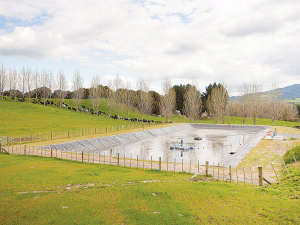Dairy sector profit still on the table, but margin gap tightens
DairyNZ’s latest Econ Tracker update shows most farms will still finish the season in a positive position, although the gap has narrowed compared with early season expectations.
 Good effluent management is having a well-designed system and processes to apply the right amount at the right time.
Good effluent management is having a well-designed system and processes to apply the right amount at the right time.
Good effluent management on a dairy farm combines a well-designed system with proper processes to ensure the right amount of effluent gets applied to pasture at the right time.
This not only saves on fertiliser costs and enhances soil health but also helps prevent animal health problems and ensures compliance with local rules. Understanding soil water deficit is crucial to prevent run-off and applying effluent to saturated soils.
There are tools available, such as the DairyNZ Farm Dairy Effluent Spreading Calculator, to help manage the application of effluent nutrients with precision. Finally, regular maintenance of your irrigation application equipment is vital for optimal performance.
Good effluent management is a combination of having a well-designed effluent system and processes for people that make sure the effluent the system collects is applied to pasture in the right amount at the right time.
On-farm benefits of good effluent management include:
Making good effluent irrigation decisions
The key to good decision making is understanding the soil water deficit. It is essential to prevent ponding and runoff and to avoid applying effluent to saturated soils.
Soil water deficit is the amount of water (i.e. effluent) which can be applied to the soil before it reaches field capacity (which refers to the amount of water held in the soil after excess water has drained away). If effluent is added at field capacity it will likely result in ponding, runoff or leaching.
Effluent spreading
New Zealand’s dairy farm systems produce large quantities of nutrient- rich effluent which are captured from milking sheds, holding yards, feed pads, standoff pads, and animal shelters. The average dairy cow produces about $25 worth of nutrients annually as farm dairy effluent (FDE). For a 400-cow dairy herd this represents about $10,000 of nutrients annually. Using effluent to supplement fertiliser presents an opportunity to capitalise on a cost-effective nutrient resource while improving whole farm nutrient use efficiency.
Effluent is commonly grouped into three broad categories based on dry matter (DM) content: liquids (0–5%), slurries (5–15%) and solids (>15%).
Application of effluents is typically via land.
Effluent application to pasture
To get good value out of effluent and reduce environmental risk consider:
Where possible, leave a buffer strip next to waterways and farm boundaries and know your consent conditions and/or regional rules.
Article - DairyNZ
The National Wild Goat Hunting Competition has removed 33,418 wild goats over the past three years.
New Zealand needs a new healthcare model to address rising rates of obesity in rural communities, with the current system leaving many patients unable to access effective treatment or long-term support, warn GPs.
Southland farmers are being urged to put safety first, following a spike in tip offs about risky handling of wind-damaged trees
Third-generation Ashburton dairy farmers TJ and Mark Stewart are no strangers to adapting and evolving.
When American retail giant Cosco came to audit Open Country Dairy’s new butter plant at the Waharoa site and give the green light to supply their American stores, they allowed themselves a week for the exercise.
Fonterra chair Peter McBride says the divestment of Mainland Group is their last significant asset sale and signals the end of structural changes.
President Donald Trump’s decision to impose tariffs on imports into the US is doing good things for global trade, according…
Seen a giant cheese roll rolling along Southland’s roads?